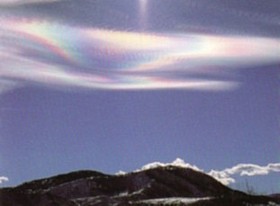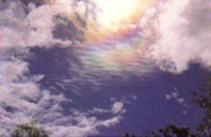
THE AIRLINE PILOTS FORUM & RESOURCE
Iridescence |
| Source: Excerpt from The Book " Weather " |
 |

Iridescence appears as irregular patches of color in middle-level clouds adjacent to the Sun or the Moon. It is best understood as a partial, or imperfect, corona, as it is formed by the same process of light diffraction around water droplets. Iridescence lacks the symmetry of a corona, appearing as diffuse patches of color within the cloud, or as fringes of color on the cloud's edge. The observer on the ground will see iridescence instead of a corona when the water-droplet cloud is too small to produce the symmetrical rings of a corona, or if the Sun or Moon is not directly behind the cloud.
The observable colors of iridescence depend upon the size of the water droplets in the cloud and the angle at which the observer sees them. Blue, which forms the inner ring of a corona, is normally the dominant color, but reds and greens may also be visible. The brightness of
these colors increases with the number of droplets in the cloud and the uniformity of their size. As with coronas, uniformly small droplets produce the best visual effect, and therefore newly formed altostratus or altocumulus clouds provide the best conditions for iridescence.
Iridescence associated with the Sun will produce stronger colors, but they will often be overwhelmed by the brightness of the Sun. Moonlight produces paler colors but a better opportunity to see them. Iridescence, although an unusual phenomenon, can occur in virtually any part of the world, although it is most common in winter over mountains. When observed over a large city, it is likely to generate great curiosity. |
Acknowledgement: John W. Zillman, William J. Burroughs,
Bob Crowder, Ted Robertson, Eleanor Vallier-Talbot and Richard Whitaker.

